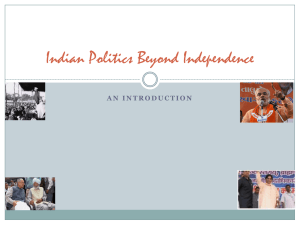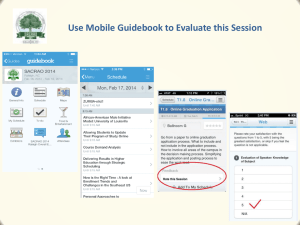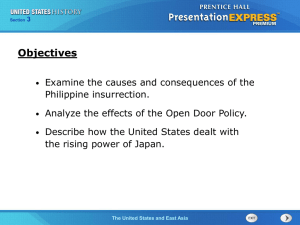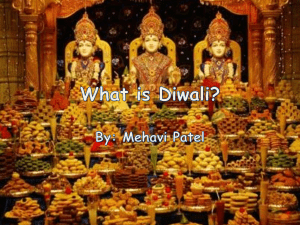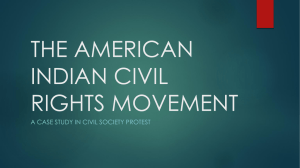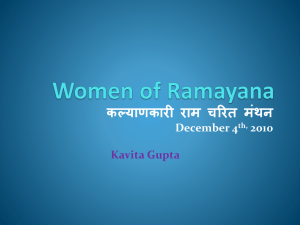SQ Sec 3 Part 3
advertisement
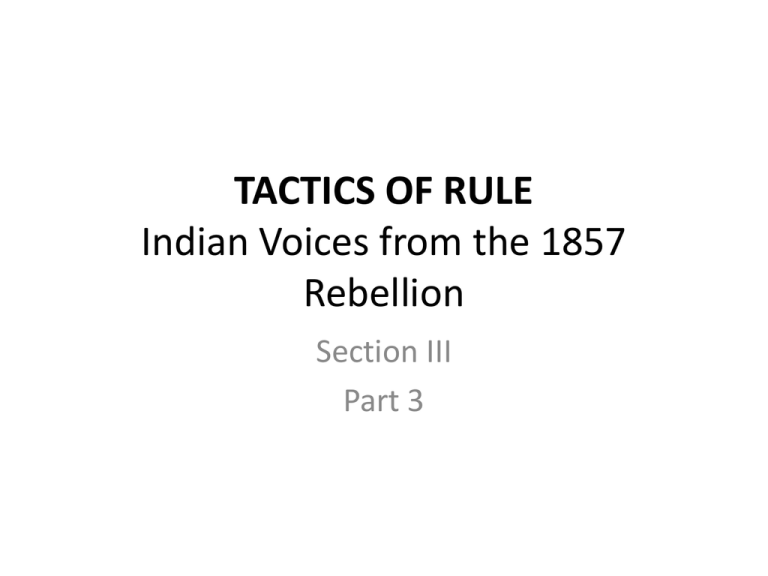
TACTICS OF RULE Indian Voices from the 1857 Rebellion Section III Part 3 Coohill’s Article • The Indian Rebellion of 1857 was a vastly important event in the history of the British Empire. • Because history is written by the victors, few ______________ accounts of the rebellion are extant. • To gain insight into the Indian consciousness during the rebellion, ____________________dives into the writings of – Sita Ram, – Vishnubhat Godse, and – Pandurang Mahipat Belsare JOSEPH COOHILL • Assistant Professor of History at Duquesne University • co-editor of India, Britain and the Rebellion of 1857 – _______________worked as the other co-editor of this forthcoming work – Sumit Guha translated the extracts from Vishnubhat Godse and Pandurang Mahipat Belsare in this article The Indian Rebellion • The Indian Rebellion constitutes one of the most important events in the history of the British Empire – also called the Indian____________ – Indian soldiers in the East India Company’s ___________army • revolted against their officers • captured and killed civilians, almost overthrowing British rule in_____________India in the process Indian Voices • PERSPECTIVES – Indian ….few and far between – Perspectives from Britons and Europeans abound – As the adage goes, history is written by the victors • The Indian accounts that do survive give great perspective on the rebellion – reveal the _____________ of rebels’ armies as well as their fighting ________________ – Many Indians experienced great personal difficulties in remaining _____________ to the British – reveal the importance of ____________ communication and rumor throughout the Indian Rebellion – Surviving accounts are incredibly personal, detailing narrators’ personal experiences • Very few comments regarding the wider rebellion and its legacy exist in these accounts • Some native conceptions of British rule in India do seep through • A couple accounts state the involvement of the British government and Parliament in creating the conditions that led to rebellion THE RISING MANGAL PANDEY TIMELINE Causes of the rebellion • One often-cited cause of the Indian Rebellion is the implementation of new ___________________ – Many sepoys believed that ______________________greased these new cartridges – Sepoys needed to bite open these cartridges • They would thus come into direct contact with pig and cow grease • Muslims and Hindus, respectively, found this action offensive – The rifle cartridges merely served as a _________________ for grievances that lay just under the surface • The Indian infantrymen of the East India Company saw their ______and _________ decline in the years before the Indian Rebellion – British officers in the 1840s in the Company army did not grant the ______________and sympathy that previous generations had done Lord ________ introduced the Doctrine of ________ to the East India Company • Governor General of India from 18____ to 18____ • The doctrine allowed the East India Company to extend its control if a native ruler died without a _____________heir – The company determined the legitimacy of heirs • Indian tradition maintained that ______________ children maintained the same inheritance rights as birth children – The British East India Company did not recognize adopted heirs • The application of the Doctrine of Lapse in_______was the straw that broke the camel’s back – The seizure of the rich and historic Oudh constituted a cultural ________________ INDIAN DISCONTENT • The sepoys’ grievance reflected a greater discontent present throughout urban and rural _________ • This dissatisfaction prompted the rapid spread of the Indian Rebellion throughout India Sita Ram • Sita Ram served as a sepoy in the Bengal army – Ram remained loyal to the British throughout 1857 and 1858 • In 18_____, the soldier wrote down his experiences through the Indian Rebellion – This account provides the strongest opinion about the causes of mutiny – Ram stated that the 18____ annexation of ______caused widespread discontent with the British • He argues that the greased rifle cartridges were_______the primary cause – Ram did acknowledge the quickness with which the cartridge story spread DemiTranslation The British East India Company’s seizure of Oudh caused the sepoys to plot the Indian Rebellion. The unjust display of British imperial power over a traditional northern Indian kingdom unsettled many Indians, especially those with social and economic ties to the region. The rumor of greased rifle cartridges only reached sepoys after news of ______’s seizure had already enraged them. DemiTranslation The Sirkar coincidentally sent groups of men from each regiment into different garrisons for instructions on how to use the new rifle. These men performed this drill until a report surfaced that the new rifle cartridges used cow and pig fat for grease. The men in our regiment wrote letters containing these facts to the rest of us. Soon, every regiment had heard about the news. Men pointed out that the Sirkar had never insulted our religion in forty years. The sepoys, however, still had the seizure of Oudh on their minds. Some soldiers pointed out that the English strived to turn us all into _________________. These men asserted that the British instituted the greased cartridge in order to make this conversion happen. Both Muslims and Hindus experienced ______________ by using the new rifle cartridges. Vishnubhat Godse • Vishnubhat Godse travelled throughout northern India in 18_____ • This young ____________ priest observed many important events and held discussions with countless people including native soldiers – Godse met two soldiers near ____ in late February or early March 1857 • Mau is located in modern-day __________________ • Godse’s 18____recounting of this event grants scholars insight into the early turnouts of a rebellion – The rifle cartridge rumors only inflamed tensions followed the seizure of Oudh – These soldiers remained convinced that ____________________ itself sanctioned the greased cartridges – Parliamentary debate did not actually exist on the greased rifle cartridges prior to the Indian Rebellion • The belief of a British-conceived forced conversion perpetuated itself in the army DemiTranslation We stopped to eat and rest for the night at a settlement just three marches from a camp at Mau. No travelers were present at the settlement, but two soldiers were. These men were returning home via ________ (Bombay). A few of us went to sit by the soldiers and chew betel. We talked about all kinds of topics, and the soldiers became quite friendly. The soldiers eventually told us that a revolution would occur in just three days. Killing and looting would inevitably result from the revolution. The soldiers warned us to return home, and we asked them to tell us exactly the news they had received. DemiTranslation The older of the two soldiers began to explain the events to us. He said, ‘‘The British have previously governed well, but they have recently become ______________.’’ Four or five months ago they sent us wonderful English guns. These guns pleased soldiers, for they used bullets the size of ___________ fruit and the balls flew 200 more paces than the old muskets. New guns and ammunition were distributed through Hindusthan. New cartridges, however, had to be bitten open. An ammunition factory has been opened at _____________(or Dum Dum) just four kosa from Calcutta in Hindusthan. One day, a ________ was taking water from a pond when a _______________a streetsweeper) approached the priest, asking to borrow his water-jug to drink. The Brahman soldier did not allow the Cambhar to drink, as the Brahman stated the water would become polluted. The Cambhar then instructed the Brahman to not talk so highly about caste superiority. The Cambhar explained that he greased the new rifles cartridges with cow and pig fat himself. The Cambhar asked, ‘‘What remains of your supposed purity when you open these cartridges with your teeth? Who needs the sham of purity in this situation?’’ The Cambhar and Brahman then began fighting. Many people, including soldiers, gathered around and heard all of these events. _____________soon spread that the new cartridges went against traditional religion. Pandurang Mahipat Belsare • Pandurang Mahipat Belsare found himself in a difficult position in early 1857 – Pandurang’s family lived well prior to 18______ • The British government took over the estate on which his family had worked for generations in this year – By 1857, the ___-year-old Pandurang realized that all business ventures he had attempted with his brothers had failed – Pandurang sought adventure outside of his native _______ • His father would not grant him permission to leave • Pandurang secretly left with a cousin from a nearby village • Pandurang wrote a memoir in _________ – This record gives accounts of life in the Indian rebel army Pandurang Mahipat Belsare • Pandurang and his cousin were immediately taken before _________ – Tope worked as a rebel leader under __________________ – Most scholars consider Tope as the genius who kept the Indian Rebellion growing • Pandurang and his cousin saw major action near __________in modern-day ____________ – In his memoir, Pandurang demonstrates the____________of battle – Rebels often had struggles in the __________________and effective use of their army • Rebel armies often handily defeated troops of the East India Company – Tales of ___________ and disorganization often appear, however, in Pandurang’s memoir More tales from the Indian Rebellion • _____________echoes the sentiments of Pandurang – Ram was captured by rebel forces and witnessed many of their battles • Rebels had to endure strenuous conditions during long campaigns – This loss of ____________partially contributed to the victory of the British East India Company – After only a brief stint in Tope’s army, Pandurang complained to a fellow soldier • Living inside native fortifications did not necessarily increase living conditions – Vishnubhat Godse occupied the rebel fort of _________ during the British attack in April 18_____ – Godse’s story only refers to the Jhansi attack • Many Indians experienced similar fears of the most likely vengeful British army ____________’s Is the Only Account of a Sepoy Who Remained Loyal to the British • Only the personal narrative of Sita Ram gives an account of a sepoy who remained loyal to the British – Ram reported the discontent in the Company’s forces to his commander in early 1857 Sita Ram’s Is the Only Account of a Sepoy Who Remained Loyal to the British • Sita Ram felt like he was being watched after this incident – Fellow sepoys believed that Ram was betraying them because he had discussed their emotions with British officers – Indian rebels captured Ram during the uprising • These sepoys tested Ram’s resolve in remaining loyal to British troops • They ___________ to and _______________ him as he was kept in chains – Ram believed these actions were either to force British intelligence from him or to convert him to the rebel side of the Indian Rebellion – The most effective strategy was to show him the famous proclamation from the King of __________ from May ____ • This method almost converted Sita Ram Sita Ram’s Loyalty • Ram remained loyal throughout his captivity – British irregular _____________ eventually rescued Sita Ram – Ram’s rescue may have increased his desire to ___________ traitorous sepoys – The writings of Sita Ram mention a _____________felt when fighting among the irregulars A Test of Loyalty • Ram experienced a severe test to that loyalty near the end of the rebellion – He found himself in charge of the _______________ of rebellious sepoys in early 1858 • One day, Ram realized that one of the prisoners was his _________ • The two had not seen each other for many years • Ram pleaded with his superiors to not have to kill his own son • Ram was _____________of the duty of execution after his son was questioned • Nevertheless, his son was shot along with the rest of the prisoners THE PASSAGE • The following passage ends the mutiny portion of Ram’s memoir • This passage symbolizes both – the personal _____________ of sepoys as the rebellion ended and also – the way in which first-hand accounts of the rebellion have survived • Much more Indian evidence would likely be present if the Indians had succeeded in the Indian Rebellion • Defeated sepoys feared ________________ from the British – These men were most likely hesitant to tell their side of the story • The accounts presented in this article survive – The rest have been scattered throughout history DemiTranslation The kind Major allowed me to perform ___________________ over my misguided son. He was the only prisoner to receive such rites, as the rest were thrown to the jackals and the vultures. WORKBOOK • Nothing unites like a common enemy. Circle the choice that best completes the sentences here about the Indian Rebellion of 1857. 3.24 EITHER/OR (p. 95) • 1. Most of the accounts of the Indian Rebellion or Mutiny of 1857 are told from British or (INDIAN, EUROPEAN) perspectives. Since history is written by the (WINNERS, LOSERS), very few accounts—except a few (DENIALS, PROCLAMATIONS) from the leaders themselves—tell the (BRITISH, INDIAN) perspective on the events of this important event in the history of the British empire. 3.24 EITHER/OR (p. 95) • 2. The few Indian narratives which survive tell about four things: (1) the condition of the rebels’ armies and (ENCAMPMENTS, MORALE), (2) the nature of (INDIAN, BRITISH) fighting techniques, (3) the extent and importance of (WRITTEN, ORAL) communication and rumor during the rebellion, and (4) the great (PERSONAL, COLLECTIVE) difficulties of remaining loyal to the British. 3.24 EITHER/OR (p. 95) • 3. The Indian accounts were highly personal with (MUCH, LITTLE) comment about the rebellion as a whole. They do, however, explain the native point of view of British rule in India and the part the (GOVERNMENT, MILITARY) played in provoking the rebellion. 3.24 EITHER/OR (p. 95) • 4. The catalyst to the revolt was the introduction of rifle cartridges greased by cow and pig fat. Since the Indian soldiers, called sepoys, were to (BITE, TEAR) open the cartridges this was offensive to both the (HINDUS, MUSLIMS) who don’t believe in eating pig products and (HINDUS, MUSLIMS) who don’t eat beef. 3.24 EITHER/OR (p. 95) • 5. Sepoys were also angry about other things too, including a (DECLINE, INCREASE) in salary, (BENEFITS, STATUS), and respect from their company (OFFICERS, PEERS). 3.24 EITHER/OR (p. 95) • 6. Another policy, one of taking over territories where a native ruler died (WITHOUT, WITH) a legitimate heir, called the Doctrine of (LAPSE, CONTROL) greatly angered the sepoys. Some, including Sita Ram, a (PRIEST, SEPOY) in the (BENGAL, BOMBAY) army, even argued that the application of the Doctrine of Lapse in Oudh was actually the (SECONDARY, MAIN) cause of the rebellion. 3.24 EITHER/OR (p. 95) • 7. When the British claimed Oudh through the Doctrine of Lapse they greatly (ANGERED, EMPOWERED) the Indians because Oudh was a (POOR, RICH) (HISTORIC, NEWLY ADDED) part of India. The British seizure of such an area was seen as a clear (CULTURAL, RELIGIOUS) insult. 3.25 SHORT ANSWER (pp. 95-97) Rebel yell. Answer the questions in short answer form. 1. Who was Vishnubhat Godse and how was he related to the rebellion of 1857? • He was a young Brahman priest from a village north of Bombay who travelled extensively talking with native soldiers and others including two soldiers near Mau who told him of the coming rebellion. 3.25 SHORT ANSWER (pp. 95-97) Rebel yell. Answer the questions in short answer form. 2. What do the young soldiers say about the new guns and bullets sent to them by the English? • The soldiers were pleased with the new equipment because it carried further—then the soldiers found out the cartridges were greased in cow and pig fat. 3.25 SHORT ANSWER (pp. 95-97) Rebel yell. Answer the questions in short answer form. 3. How did the soldiers find out about the fact that the cartridge packets were made with cow and pig fat? • One day a street sweeper, a Cambhar, came upon a Brahman who was taking water from a pond. The Cambhar asked the man to lend him a water-jug so that he could drink. The Brahman wouldn’t, replying that the water would be polluted if he did. The Cambhar told him not to talk about being so much better since the cartridges the Brahman was tearing open with his own teeth were greased with cow and pig fat. 3.25 SHORT ANSWER (pp. 95-97) Rebel yell. Answer the questions in short answer form. 4. How did the soldiers in Godse’s story believe the British Parliament responded to the cartridge controversy? Was this accurate? • They believed that parliament planned the use of the cartridges. They believed that a saheb1 vowed before Parliament to force the sepoys to accept the cartridges. The truth was that no military debate about the cartridges came up before Parliament prior to May 1857. 3.26 CAUSE/EFFECT (p.97) 3.26 CAUSE/EFFECT (p.97) They are sentenced to 10 years hard labor, stripped of their uniforms, and humiliated. The siege of Delhi ends with the British capture of the city, and the military tide turns against the rebels Nana Sahib issues proclamation for all Indians to join the rebellion 3.27 JEOPARDY (pp. 98-100) • 1. This twenty-one year old Indian left his home in Pathardi seeking adventure in 1857. • Who was Pandurang Mahipat Belsare? 3.27 JEOPARDY (pp. 98-100) • 2. This man was a great rebel leader under the command of Nana Sahib. • Who was Tatya Tope? 3.27 JEOPARDY (pp. 98-100) • 3. Pandurang and his cousin were employed as a part of the rebel army after they were proven to not be working as this. • What are spies? 3.27 JEOPARDY (pp. 98-100) • 4. In Pandurang’s account of a battle near Khajuri, he describes the struggles that the Indian army had with this aspect of battle. • What is organization? 3.27 JEOPARDY (pp. 98-100) • 5. Pandurang’s stories about the rebel armies often involve these two themes. • What are disorganization and flight? 3.27 JEOPARDY (pp. 98-100) • 6. This man also wrote of the weak fighting of the sepoys who had the English greatly outnumbered at Delhi and yet lost. • Who was Sita Ram? 3.27 JEOPARDY (pp. 98-100) • 7. Vishnubhat Godse also wrote of the conditions within the rebel armies, particularly the attack here. • Where is Jhansi? 3.27 JEOPARDY (pp. 98-100) • 8. Of all the personal narratives that survive, only Sita Ram’s gives us an account of this phenomenon. • What is an Indian soldiers who remained loyal to the British? 3.27 JEOPARDY (pp. 98-100) • 9. Sita Ram almost turned against the British when he was shown this. • What is the proclamation of May 11th from the King of Delhi? 3.27 JEOPARDY (pp. 98-100) • 10. Sita Ram remained loyal to the British and was given this task by the British in the early 1858. • What is the execution of rebellious sepoys? 3.27 JEOPARDY (pp. 98-100) • 11. In the most troubling account of the rebellion, Sita Ram wrote of being asked to execute this man. • Who was his son? 3.27 JEOPARDY (pp. 98-100) • 12. According to Ram’s accounts, this was the fate of the bodies of the rebel soldiers. • What is that they were left out in the open, thrown to the jackals and vultures—except for Ram’s son who was allowed to receive proper funeral rites? 3.28 QUOTING (pp. 95-100) Sita Ram Vishnubhat Godse The seizure of Oudh using the British policy of Doctrine of Lapse The account he received from two soldiers he met near Mau. 3.28 QUOTING (pp. 95-100) Sita Ram Vishnubhat Godse The speed with which objections to the new cartridges spread amongst the sepoys. The Indian belief that the British Parliament had sanctioned the use of the cartridges. 3.28 QUOTING (pp. 95-100) Pandurang Mahipat Belsare Pandurang Mahipat Belsare Sita Ram The encounter Pandurang and his cousin had with rebel leader Tatya Tope who at first believed the men to be spies. The conditions of the rebel army—their confusion, disorganization, and inefficiency. The poor organization and fighting inefficiency of the Indian rebel army, who lost even battles where they seemingly had the advantage 3.28 QUOTING (pp. 95-100) Pandurang Mahipat Belsare Vishnubhat Godse The decision he made to join Tope’s rebel army where there was suffering (not enough food, clothing, adequate shelter, etc.) The British siege of Jhansi in April 1858 where a brutal massacre took place 3.28 QUOTING (pp. 95-100) Sita Ram Ram’s decision to stay loyal to the British government Sita Ram Ram’s burial of his son’s body after his son was executed for rebelling against the British government.



